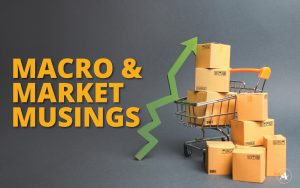Comments based on information available as of 5:45am CT on 11/28/2025
Growth: Squaring The Circle 
Consumer confidence has returned to levels near the historic lows we saw last April, when President Trump announced tariffs and the market dropped nearly 20%. However, the level of consumer confidence has little to do with the level of the markets. Earnings growth has been stronger than expected despite low confidence. It’s not just information technology (IT) that is experiencing earnings growth. According to FactSet’s earnings scorecard for the S&P 500, while IT earnings growth is up 28.5% from a year ago, financials, utilities, materials, and industrials earnings growth are all up more than 15%. Companies are doing a good job navigating in this dynamic environment.
Inflation: Choose Your Own Adventure
The Bureau of Labor Statistics will not release October and November consumer price index data until mid-December, but several real-time measures provide an early look—and they tell different stories. Truflation reports a year-over-year inflation rate of about 1.8%, while Bloomberg and the Federal Reserve Bank of Cleveland estimate around 3%. State Street’s PriceStats falls somewhere in between. For individuals, the experience depends on what they buy, but the broader trend suggests that the tariff shock, which initially fueled inflation fears, is now easing. That does not mean the impact of higher prices has disappeared. Inflation measures the rate of change in prices, not the price level itself. Still, it appears that prices are not rising as quickly or as much as many originally feared.
Policy: A New Head At The Fed?
With Jay Powell’s term as Chair of the Federal Reserve up in May, the betting markets have Kevin Hassett (Director of the National Economic Council) as the leading contender to sit in the chair at the head of the table. Hassett is expected to advocate for lower interest rates, but the chair does not set policy alone. While the position carries significant influence, decisions are made by the 12 voting members of the Federal Open Market Committee, each with an equal vote. The chair’s ability to shape policy ultimately depends on persuading others to align with his views.
Looking Ahead: Every Little Bit Helps
Investor attention can shift quickly. Lately, markets seem to be driven mostly by changes in expectations of whether the Fed will or won’t cut rates when it meets December 9-10. As the odds of a rate cut have gone up, so have the equity markets. Would a 0.25 percentage point reduction in the federal funds rate make a significant difference? Not by itself, but it carries important signaling value. A cut could indicate not only that the Fed recognizes signs of a softening labor market, but—more importantly—that it is prepared to act in response.